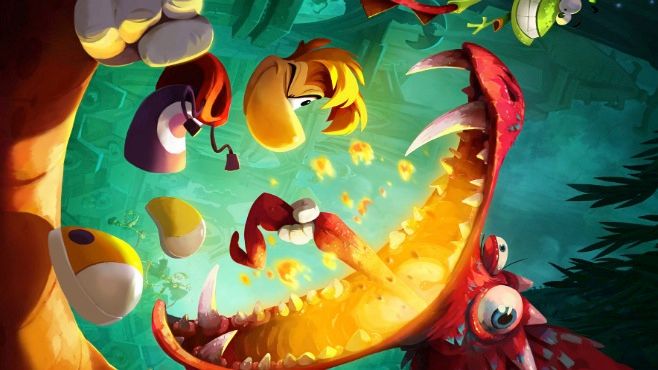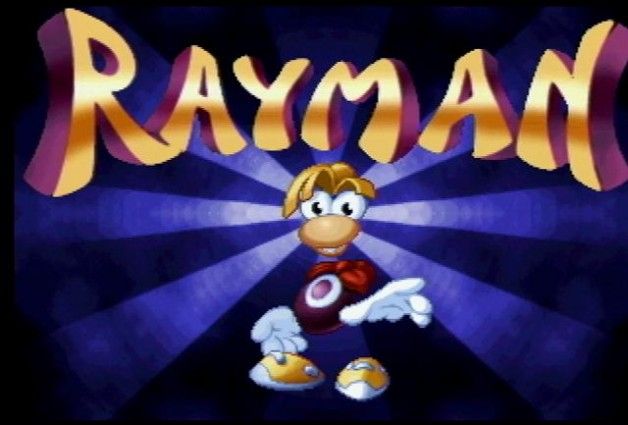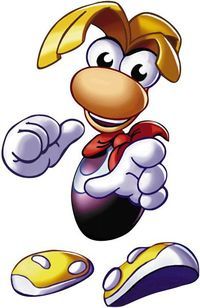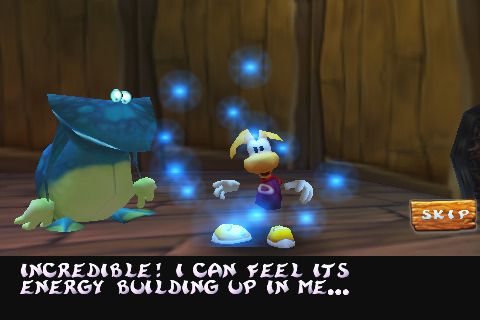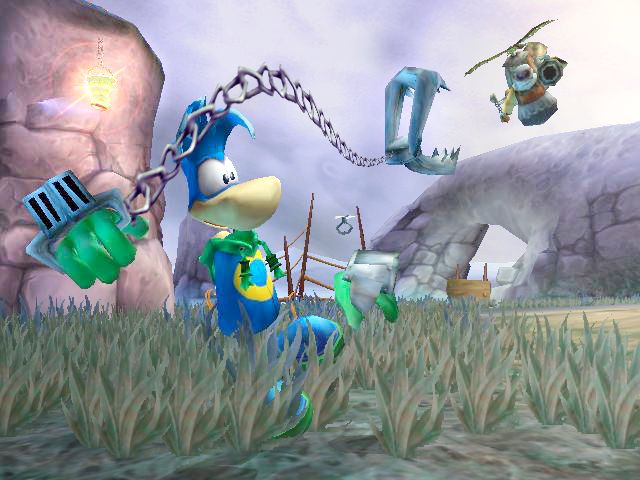Rayman and his wacky adventures have always held a special place in my heart. In the heyday of the ‘90s platforming era, iconic characters and “mascots” practically defined a console generation, with Rayman being a part of them. Mario proudly championed Nintendo while Crash Bandicoot and Spyro the Dragon took the reigns of PlayStation, and Sonic the Hedgehog kept Sega as a relevant console producer with his dizzying high-speed adventures.
And then there was Rayman.
Rayman didn’t have a console to represent him or a generation to stand up for – Rayman instead quietly solidified his place as a charming, fantastical, and inventive platform adventurer with a little bit of everything, and for me, made him easily stand alongside Mario, Sonic, or Crash. The history of Michel Ancel’s iconic character only shows that, with almost two decades of Rayman on nearly every console and platform imaginable, Rayman as a series that has evolved, innovated, and most of all, been superbly fun.
From the early days of Rayman’s 2D debut to his rebirth in the present with Rayman Origins and its sequel, Rayman Legends, the famous limbless hero has had a storied history in gaming, and in the latest installment of Then and Now, we’ll begin to retell it.
Rayman - No Limbs, All Heart (1995)
Like Mario, Sonic, or any of the other classic mascots, Rayman started from humble beginnings as a 2D platformer that would launch the limbless wonder into the series’ further success today - but of course, every legend needs an origin, and every series needs a starting point.
Originally created in 1994 by game designer Michel Ancel, Rayman was introduced to the world in September 1995 for the Atari Jaguar, followed shortly by versions of the game for MS-DOS, Sega Saturn, and PlayStation. While names like Jaguar and Sega Saturn are only distant memories nowadays, at the time they represented a big surge in unique franchises and new games, and when Rayman was released it was chiefly among them.
A 2D platformer with a wild mixture of levels and challenges was nothing unknown at the time - this is the ‘90s we’re talking about, and Mario and Sonic had already been old-timers perfecting this successful routine for years before Rayman came along. But, Michael Ancel brought a unique take with Rayman - a platformer full of charm and a distinctly European touch.
Influenced by fairy tales from a variety of cultures (primarily a slew of Russian and Celtic children’s tales), Ancel and his team originally developed Rayman for the Super Nintendo, only to be moved over by Ubisoft for CD-ROM-based consoles for the memory and processing power that the (at the time still relatively new) technology offered instead of cartridges.
With the development change also came a new art direction, as artists with backgrounds in cartooning and animation that brought considerable graphical changes, and also brought the famed art direction and style that would define Rayman for the coming decades.
As the platformer that set the precedent for the series, Rayman’s unique mixture of art and design provided an alternative for the (very-crowded) platforming genre. Sure, Rayman could run, jump, punch, and glide like many of his mascotting rivals, but the vivid life and detail in the game’s art, the humor and charming atmosphere of the game, and the surprisingly intense difficulty of the game provided a whole new world within an increasingly familiar landscape of platform gaming.
Right from the very beginning, Rayman may have seemed a bit odd compared alongside Mario or any of the other platforming giants. Sure, he was missing some limbs, and he could glide with his hair! But, the introduction of Rayman proved that Ancel’s creation wasn’t missing any heart or sense of joy when he first burst onto the platforming scene, and going into the follow-up sequel, Ubisoft proved that Rayman was here to stay.
Rayman 2: The Great Escape - A Flight of Fancy (1999)
Ubisoft took a big leap forward with their follow-up to Rayman by following the footsteps of Mario and Sonic into 3D platform gaming, with games like Super Mario 64 and Sonic Adventure taking the next big step. Luckily though, Ancel and Ubisoft’s risk paid off big by creating a platforming masterpiece all their own.
Rayman took the plunge into 3D with the release of Rayman 2: The Great Escape by introducing Rayman to The Glade of Dreams, an army of robo-pirates, and a fanciful platforming adventure that took full advantage of 64-bit era’s capabilities and power. By debuting first on the Nintendo 64, The Great Escape stunned on virtually every front, and was my first real gateway into the Rayman franchise - so much so that at the time, I didn’t have a Memory Pak for my N64, and had to restart the game from the beginning every single time that I wanted to play it when I was a kid. But, Rayman 2: The Great Escape was such a joy to play that it didn’t make all the different that I watched those opening cutscenes several dozen times - I always enjoyed it just like it was the first time I started up the game.
With Globox and Ly the Fairy at his side, The Great Escape brought the eye-popping detail and art that Michel Ancel and his development team introduced in the original Rayman and seamlessly brought that over into the 3D world. Rayman 2’s Glade of Dreams and its numerous worlds were beautiful to look at and full of life and color - even in the realm of the notoriously blurry, muddy textures of Nintendo 64 games of the past, Rayman 2 popped. Even with a slightly darker story with some fairly menacing baddies to fight and monsters to avoid, Rayman 2 shined with exemplary levels and platforming that easily let it stand alongside many of the other Nintendo 64 classics of the time.
With being ported over to almost every system imaginable, Rayman 2: The Great Escape presented the series at one of its highest points throughout its history (at least until the series’ rebirth with Rayman Origins: but, more on that later). Originally released for the Nintendo 64 in October 1999, Rayman 2: The Great Escape soon found itself on many different platforms across a range of console generations - The Great Escape could later be found on PC, Dreamcast and PlayStation in its initial release, followed by many ports on other systems (Rayman 2: Revolution for PS2, Rayman DS for Nintendo DS, and Rayman 3D on 3DS).
Whether it was in its original experience on the Nintendo 64 or on commutes home with the iPhone, Rayman 2: The Great Escape may have some of its grievances when played now (wonky camera and some dodgy control issues aside), but its numerous 9’s and 10’s from its original debut absolutely hold Rayman 2: The Great Escape up not only as a defining N64 experience (and one of its best games), but as a stunning example that Rayman could easily stand up to Mario any day.
Rayman Arena - Bringing Rayman to the Battlefield (2001)
After Rayman 2: The Great Escape solidified Michel Ancel’s Rayman as a true platforming hero, Rayman spent some time in a number of off-shoot spinoff titles in the few years after the sequel’s release. In the following year, Rayman entertained (and educated) kids with Ubisoft and Aqua Pacific’s Rayman Junior, where platforming and baddie-fighting hijinks were replaced with problem-solving, word rhyming, and solving mathematical equations.
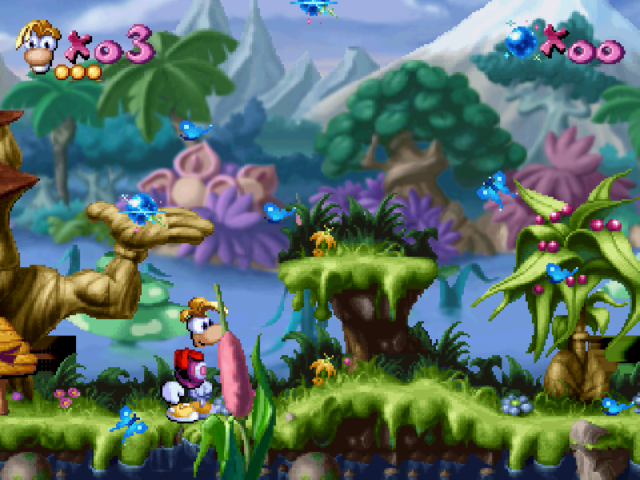 With the Xbox, GameCube, and PlayStation 2 making their names as the next generation of consoles, Rayman made his name through Ubisoft’s introduction of the series to the new consoles. Rather than a traditional 2D platformer like the original or following the trials of Rayman 2: The Great Escape, Ubisoft instead opted for a new kind of Rayman experience: Rayman Arena. Billed as an arena-style multiplayer game between four players, Rayman Arena featured Battle and Race modes between nine characters where players competed in different cups for glory: or, at least the Rayman version of glory!
With the Xbox, GameCube, and PlayStation 2 making their names as the next generation of consoles, Rayman made his name through Ubisoft’s introduction of the series to the new consoles. Rather than a traditional 2D platformer like the original or following the trials of Rayman 2: The Great Escape, Ubisoft instead opted for a new kind of Rayman experience: Rayman Arena. Billed as an arena-style multiplayer game between four players, Rayman Arena featured Battle and Race modes between nine characters where players competed in different cups for glory: or, at least the Rayman version of glory!
While Rayman Arena offered a different take on the series from its previous two incarnations, ultimately the reception on Arena was mixed with reviews taking complaint with the dated multiplayer compared to the previous highmarks of Rayman and Rayman 2. Luckily though, the tepid reception of Rayman Arena was about to change with the next major entry of the Rayman series right around the corner.
Rayman 3: Hoodlum Havoc - A Return to (Limbless) Form (2003)
Rayman Arena tried a different approach to the Rayman formula, but of course, it would only be a matter of time before Rayman returned in true form to arrive with the (at the time) new generation of consoles. Making his leap onto the GameCube, PS2, and Xbox, Rayman 3: Hoodlum Havoc brought a new Rayman with some unique changes, but luckily retained much of the delightful humor and joy that made Rayman so enjoyable in the first place.
By turning things back a little bit from the darker Rayman 2: The Great Escape, Hoodlum Havoc went back to the more light-hearted approach of Rayman of old, while in the process swapping Rayman’s energy-throwing abilities for a variety of long-ranged punches and kicks. From launching mini-tornadoes at foes to huge claws that lashed out from Rayman’s fists, Hoodlum Havoc gave Rayman some new moves in his arsenal, but much of the same wit and humor.
Bringing along improved visuals from the days of The Great Escape, Hoodlum Havoc allowed the chance for Rayman to shine and show off what the game could really do: great art and refined gameplay (and even a John Leguizamo-voiced Globox!) brought Rayman in for a new-era that improved on Rayman Arena’s failings and brought a much more positive critical reception.
However, a new Rayman platformer would not find its way to consoles after Rayman 3: Hoodlum Havoc for sometime - a GBA follow-up would release a short while after (Rayman: Hoodlums’ Revenge in 2005), followed soon after by the beginning of the Rayman Raving Rabbids spin-off series of everyone’s favorite screaming rabbit creatures.
Rayman may have had a bit of a hiatus following Hoodlum Havoc, but Ubisoft had plenty in store for Rayman - a whole new adventure was just waiting for the hero’s return.
Rayman Origins - Rayman’s Rebirth (2011)
After several Raving Rabbid titles had their success on the Wii and other consoles, it was time for Rayman proper to make a return. Since Rayman 3: Hoodlum Havoc's debut in 2003, it had essentially been over seven years since Rayman had seen action in a proper platforming title akin to his glory days, and deservedly needed a welcoming back on the current-gen. What Rayman got instead was a rebirth.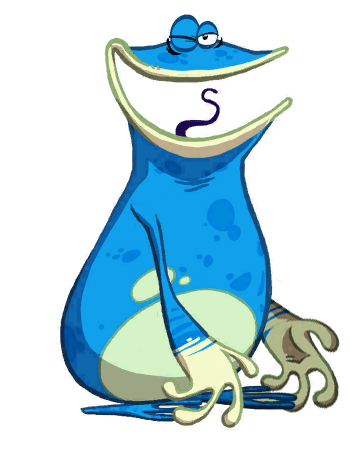
Initially developed and planned as a downloadable title, Rayman Origins was Ubisoft’s chance to begin the franchise anew with Michel Ancel and a significant portion of the series’ original creative team. If anything, Rayman Origins proved that they could wholeheartedly deliver - the title soon transformed from a downloadable game into something much bigger, much more expansive, and way more entirely fun.
Rayman Origins took things back to the basics: Rayman, his trusty (and goofy) companion Globox, and the collection of Teensies inside The Glade of Dreams must retake their treasured land from an army of evil no-good monsters after...well, snoring too loudly during one of their many naps. Rayman Origins is a ton of silliness, but even more parts goofy and deliriously fun. The game may have gone back to Rayman's roots, but in its place Rayman Origins completely revitalized everything else around those well-worn foundations. Kinetic and challenging (but superbly fun) platforming made Rayman Origins certainly a challenge, but always fun.
The real centerpiece of the Rayman Origins experience though was the art: with the introduction of the UbiArt Framework engine, Ubisoft went all out in making Rayman Origins a living, breathing (and playable) cartoon world. From every small animation of Rayman's run to Globox's wacky wobble (and jiggling gut), Rayman Origins was bursting with style and color - backgrounds popped with lush greens while The Land of the Livid entranced in its soggy purples and vividly cryptic underworld. Every inch of Rayman Origins showed artistry and life, rather than just pixels and frames - it was clearly a labor of love from the Ubisoft Montpelier team, and a love of classic Rayman platforming at that.
In addition to four-player co-op and a host of challenges and worlds, Rayman Origins was truly the whole package - one which definitely made Mario, Donkey Kong, and others take note. Rayman was back in a huge way with Rayman Origins with its release in November 2011, but with Ubisoft preparing a follow-up to the reboot, it was time for Rayman to become a legend.
Rayman Legends - A Legendary Journey (2013)
Leading up to Rayman Legends, the prospects for a sequel to Rayman Origins were not looking terribly optimistic, even leading right up into the game's development and release. Although reviews of Rayman Origins were glowing, sales were mild with the game having been priced as a full retail release at $60, and releasing right in the thick of the November holiday shopping season. As spectacular as Rayman's return was in Origins, going up against the likes of Assassin's Creed, Call of Duty, Battlefield, Skyrim, and Batman: Arkham City was definitely no easy accomplishment to overcome with a small platforming title.
Thankfully though, Rayman's most recent return wasn't his last: Rayman Legends would follow on the heels of Origins and bring Rayman and company back for another round of fantastical fun and excitement. But, like any other Rayman title, Rayman Legends would go through a few changes in the lead-up to its release. Initially announced as a Wii U exclusive launch title, the game soon underwent multiple delays - first to February 2013 just outside of the Wii U launch window, and then eventually to September 2013 to accommodate for added polish and a multi-platform release on Xbox 360, PS3, PC, and Vita.
While the delays were a bit of a bummer in the lead-up to Rayman Legends (especially for the fact that a sequel was miraculously arriving at all), the worries that Legends wouldn't be able to live up to Origins' legendary status were thankfully dismissed at the game's release - Rayman, Globox, and friends enjoyed another nap-fueled debacle that would lead to their world coming under the threat of an evil presence, Dark Teensies arised, and hilarity ensued. The charming and good-natured feel of Rayman Origins returned, but this time came with a substantial engine upgrade, improved visuals, and an overhaul of laughs and goofy humor that made Rayman Legends a pleasure to play.
Bringing an emphasis on speed and dexterity, Legends also introduced constant variety in each new world (most of the time in each new level), along with a big focus on competitive play. With the four-player co-op retained from Origins, Legends also upped the ante - the speed run-styled Invaded levels provided a challenge for those with quick minds (and even quicker thumbs), daily online speed run challenges gave a competitive streak for those looking to perfect their ability to dash through the levels, and the new Musical Levels succeeded in bringing pop tunes to the Rayman world (and forever engraining "Eye of the Tiger" into my head: try NOT to play the level just once). 
Rebooting the Rayman series definitely proved a huge risk for Ubisoft, especially in the wake of a long-running and hugely successful franchise (Assassin's Creed) alongside two hugely anticipated new ones on the way (Watch Dogs, The Division) - but, each of the new Rayman games easily swayed away any doubt. As two beautiful platformers that both honor the traditions of their past while forging ahead new paths for the future, Rayman's second-wind has been risky, but rewarding. Rayman Origins bravely reestablished Rayman as a hero worth paying attention to, while Rayman Legends made it a tale for the ages.
Running, Jumping, and Gliding Off to the Future
From its humble roots to its current revitalization, Rayman has gone through a lot of changes throughout the years. Almost two decades of history has turned Rayman from a mop-haired funny-looking mascot with no arms or legs into one of gaming's most iconic mascots across every platform. Remember, lookout Mario and Sonic - Rayman's on your tail.
Rayman still may not be quite the superstar as some of the other platforming celebrities out there, but Michel Ancel's creation has always made up for it with vigor and love - each game bursting with the willingness to go in new routes and make you laugh all along the ride. The Rayman series has always been about a world full of the ridiculous, brimming with the silly, but always chock full of heart and a love of platforming games of the past.
With Rayman Legends having just been released earlier this month, the immediate future to Rayman looks bright for the moment, but as always, it's way more difficult when trying to look ahead to see where Rayman can go. Sure, there is always the chance that there may not be another Rayman game for whatever the reason - poor sales, lack of development interest, etc.
But, after dashing through the jungles, saving the Teensies, and fighting off enormous birds and luchador wrestlers over the past two decades, I'd think it's safe to say that Rayman is up to handle just about any challenge out there.

